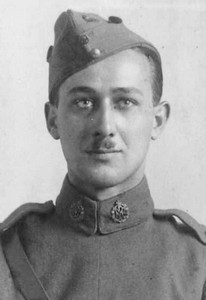Related Research Articles
Ronald Malcolm Fletcher was an English World War I observer/gunner ace in two-seater fighters who, in conjunction with his pilot, Lt. Samuel F.H. Thompson, gained 26 confirmed victories. He was notable for the fact that all but one of these victories were over enemy fighter aircraft.
Flight Lieutenant Edward Robert Pennell (1894–1974) was a British World War I flying ace credited with five aerial victories. He returned to military service during World War II.
Captain Frank Douglas Stevens was a British First World War flying ace credited with five aerial victories.
Captain Claud Harry Stokes was a British First World War flying ace credited with five aerial victories, all while flying the Airco DH.4.
Lieutenant John Herbert Greenwood Womersley was a World War I flying ace credited with five aerial victories.
Lieutenant Maximillian John Jules Gabriel Mare-Montembault MC was a British World War I flying ace credited with six aerial victories.
Captain Thomas Sydney Sharpe was a British World War I flying ace credited with six aerial victories.
Lieutenant George Raby Riley was a British World War I flying ace credited with thirteen aerial victories. He was an ace balloon buster, as well as an ace over enemy aircraft.

Captain Douglas Graham Cooke was a British World War I flying ace credited with thirteen aerial victories.
Group Captain Campbell Alexander Hoy was a British flying ace during the First World War, credited with eleven aerial victories. He remained in the Royal Air Force post-war and served through the end of the Second World War.
Captain Thomas Laurence Purdom was a Scottish World War I flying ace credited with 13 confirmed aerial victories.
Second Lieutenant John Howard Umney was an English flying ace from World War I. He flew as a gunner/observer in the rear seat of Bristol F.2B Fighters, and was credited with 13 official aerial victories.
Squadron Leader Walter Macfarlane Carlaw was a Scottish flying ace who served during World War I, and was credited with 12 confirmed aerial victories. He returned to RAF service during World War II.
Major John Charles Bradley Firth was a British World War I flying ace credited with 11 aerial victories while campaigning on the Italian Front.
Captain Leonard Allan Payne was a British First World War flying ace born in Swaziland. He was credited with 11 confirmed aerial victories while piloting a Bristol F.2 Fighter.
Wing Commander William Hastings Farrow was a British World War I flying ace credited with 10 aerial victories. He would pursue a military career well into the 1920s before resigning in 1926. Like many World War I aces, he returned to the military for World War II, and was honoured by induction into the Order of the British Empire.
Lieutenant Charles Henry Arnison was a British World War I flying ace credited with nine aerial victories. He won the Military Cross for valour in World War I, and returned to the RAF to serve in World War II.

Henry Arthur Richard Biziou, was a British flying ace of the First World War, credited with eight aerial victories. After serving successively in the Royal Navy and the British Army, he transferred to the Royal Air Force. After service as an observer, he trained as a fighter pilot and subsequently won his victories. He survived the war, only to die in a midair collision.
Captain Alfred John Brown was a World War I flying ace credited with eight aerial victories.
Wing Commander John William Rayner was a British military officer who began his career in the Army during World War I. He became a flying ace during the closing months of the war, being credited with five aerial victories.
References
- Notes
- ↑ "Douglas Evan Cameron". The Aerodrome. 2014. Retrieved 26 September 2014.
- ↑ "No. 30584". The London Gazette (Supplement). 15 March 1918. p. 3443.
- ↑ "No. 30781". The London Gazette. 5 July 1918. p. 7946.
- ↑ Shores et.al. (1997), p. 96.
- ↑ "No. 31147". The London Gazette. 28 January 1919. p. 1373.
- ↑ "No. 31378". The London Gazette (Supplement). 30 May 1919. p. 7040.
- Bibliography
- Shores, Christopher F.; Franks, Norman & Guest, Russell (1990). Above the Trenches: A Complete Record of the Fighter Aces and Units of the British Empire Air Forces 1915–1920. London, UK: Grub Street. ISBN 0-948817-19-4.